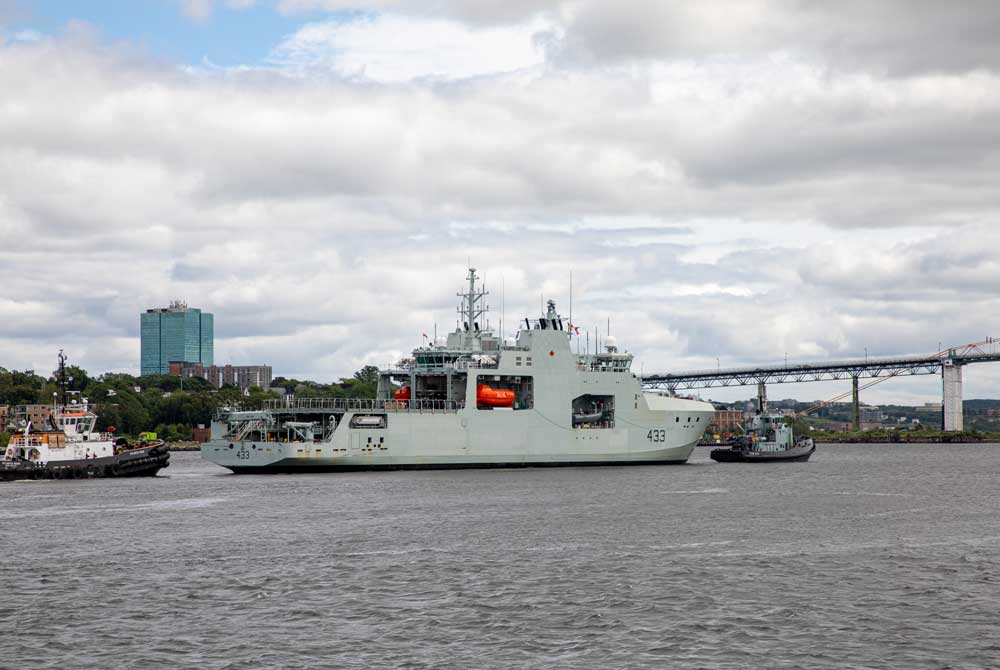On August 31st, in Halifax, Nova Scotia, the Royal Canadian Navy (RCN) welcomed its fourth Arctic and Offshore Patrol Vessel (AOPV), His Majesty’s Canadian Ship (HMCS) William Hall, into its fleet.
“Today, we celebrate the next important milestone for the National Shipbuilding Strategy and the Royal Canadian Navy with the arrival of our fourth new Arctic and Offshore Patrol Vessel, HMCS William Hall. This new asset to Canada’s fleet has been made possible by the vital work of our shipbuilders and the thousands of Canadians that have contributed to the construction of this new ship. We will continue to provide the Royal Canadian Navy with the ships needed to protect our country, while creating good jobs for Canadians,” said the Honourable Bill Blair, Minister of National Defence.
“The delivery of HMCS William Hall today, a full two months ahead of schedule, marks our most efficient production effort to date,” said Dirk Lesko, President, Irving Shipbuilding. “The ship-to-ship improvement we are seeing is a testament to the developing workforce we have here in Halifax, which is truly solidifying the Canadian shipbuilding industrial base needed to deliver on the National Shipbuilding Strategy (NSS) for many years to come,” continued Mr. Lesko.
The Harry DeWolf-class Arctic and Offshore Patrol Vessel, tailored to assert and safeguard Arctic sovereignty, represents a substantial enhancement of the Canadian Armed Forces’ (CAF) capabilities and presence in the Arctic region. Equipped with ample storage capacity for transporting cargo, accommodating small vehicles, and deploying boats, the AOPV brings versatility and vital support to a broad spectrum of domestic CAF operations. Moreover, it possesses the capacity to contribute to global peace and security in collaboration with our allies and partners.
“Today’s delivery of our fourth Arctic and Offshore Patrol Vessel, HMCS William Hall, brings the Royal Canadian Navy ever closer to achieving our full fleet of six modern, ice-capable ships. Each of the AOPV represents an advanced capability and skillset for the Navy, and our allies, and we are proud that this ship will soon be officially welcomed into the RCN Fleet,” explained Vice-Admiral Angus Topshee, Commander of the Royal Canadian Navy.
Following the delivery of HMCS William Hall to the RCN, the upcoming stages will entail conducting sea trials, assessing performance in both warm and cold weather conditions, and undertaking various post-delivery evaluation tasks. The formal commissioning ceremony for HMCS William Hall is scheduled for next year, following the completion of these trials.
Nancy Lochhead, Vice President of Production, commented, “AOPS 4, the future HMCS William Hall will have been built to completion (start to finish) a full three months faster than AOPS 3, HMCS Max Bernays. Given that production of HMCS William Hall was heavily affected by the COVID-19 pandemic, this is truly a remarkable achievement, and one which speaks to the world class shipbuilding capability we are establishing here in Atlantic Canada.”
Since the inaugural deployment of the first vessel in the class, HMCS Harry DeWolf, in 2021, these ships have been engaged in numerous missions, spanning Canada’s Arctic regions, the Southeastern Pacific Ocean, the Caribbean Sea, and providing assistance during the Hurricane Fiona response in Newfoundland. While post-acceptance work, sea trials, and final ship preparations are being finalized, HMCS William Hall will remain stationed at His Majesty’s Canadian Dockyard Halifax before its official commissioning into the RCN fleet.
“We are producing shipbuilders locally through our apprenticeship program, the largest in Atlantic Canada. These people will have the opportunity to work their entire careers here at the Halifax Shipyard thanks to the NSS. The fact we have seen such growth in our efficiency, even with so many new shipbuilders, is really something to be proud of,” added Mr. Lesko.
In line with Canada’s defense policy, known as “Strong, Secure, Engaged,” the Government of Canada continues its commitment to deliver state-of-the-art, functional, and efficient vessels required by the RCN for its operations. Simultaneously, this endeavor contributes to the resurgence of Canada’s marine industry by generating hundreds of new jobs, all as part of Canada’s National Shipbuilding Strategy.
Born in 1827 in Horton, Nova Scotia, William Hall, the offspring of former American slaves, made history by becoming the first Black individual, as well as the first Nova Scotian and one of the earliest Canadians, to be bestowed with the esteemed Victoria Cross, the British Empire’s highest commendation for acts of valor. His noteworthy achievement in the Royal Navy earned him this prestigious recognition. During an era dominated by wooden vessels, Hall’s formative years were marked by aspirations shared by many young boys, dreams of navigating the globe aboard sailing ships. Before embarking on his naval career in 1852, Hall spent several years laboring in shipyards at Hantsport following a period of employment aboard merchant vessels.
Some Key Characteristics of the future HMCS William Hall:
- Length: 103.6 metres
- Beam: 19.0 metres
- Speed (open water): 17 knots
- Complement: 65 crew + 20 embarked forces
- Endurance: 120 days
- Range: 6,800 nautical miles at 14 knots
- Integrated diesel-electric power and propulsion
- Bow thruster for maneuvering and berthing without tug assistance
- Retractable active fin stabilizers for roll reduction
- Ability to operate and hangar a CH-148 Cyclone or small utility helicopter

